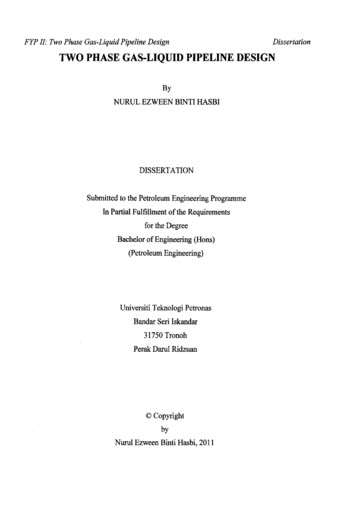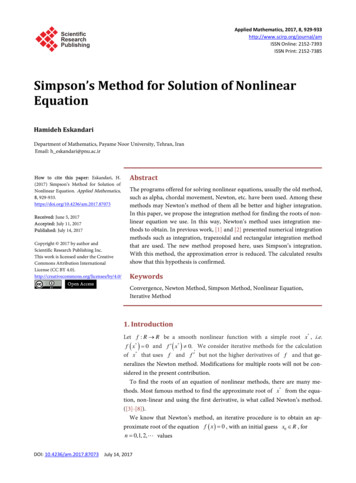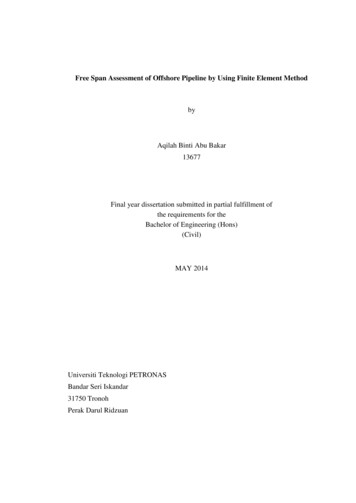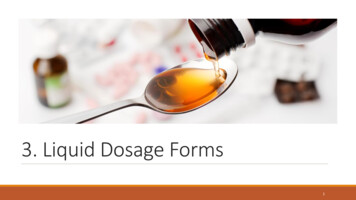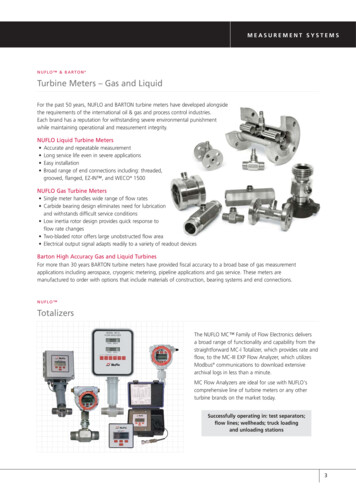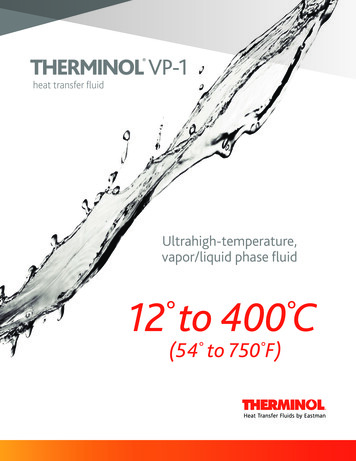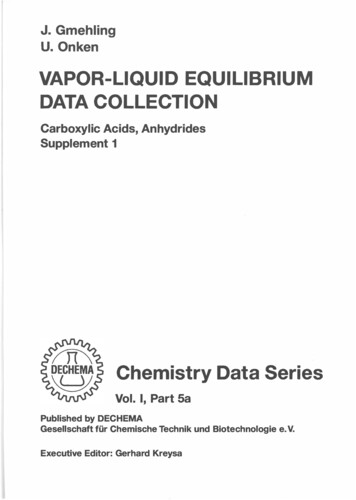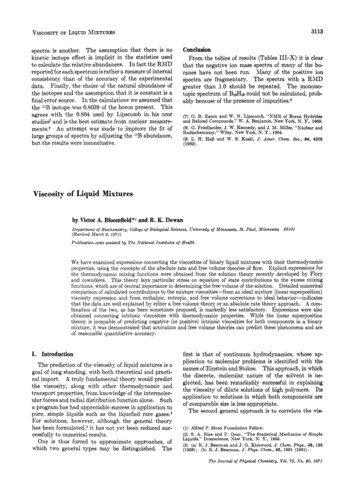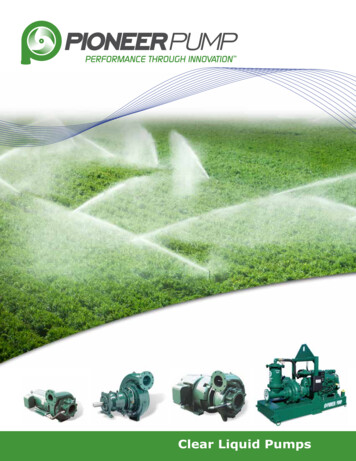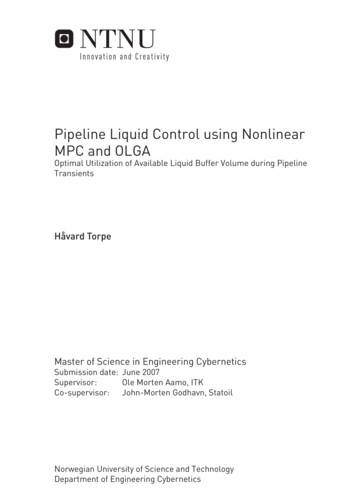
Transcription
Pipeline Liquid Control using NonlinearMPC and OLGAOptimal Utilization of Available Liquid Buffer Volume during PipelineTransientsHåvard TorpeMaster of Science in Engineering CyberneticsSubmission date: June 2007Supervisor:Ole Morten Aamo, ITKCo-supervisor:John-Morten Godhavn, StatoilNorwegian University of Science and TechnologyDepartment of Engineering Cybernetics
Problem DescriptionAt the Hammerfest LNG plant, a huge slug catcher is installed for receiving gas, condensate andwater from the Snøhvit field pipeline. The purpose of the slug catcher is to separate gas,condensate and water and to buffer varying gas and liquid rates from the pipeline. The gas flowfrom the slug catcher should be as constant and predictable as possible for optimal operation ofthe LNG plant. The sizing of the slug catcher is based on handling the liquid flow from a desiredfast start-up of production after a set of selected scenarios with low or no production. Thequestion raised in this exercise is whether the slug catcher size could have been reduced byapplying nonlinear model predictive control (NMPC) using some combination of input. Possiblemanipulated variables include: the subsea choke (at the pipeline inlet), the topside choke (at thepipeline outlet) and the gas rate out of the separator. A simple feedback scheme for liquid flowcontrol was developed, implemented and tested in a project. The results were promising, but apotential for more advanced control was identified.1. Literature review on MPC with particular focus on NMPC.2. Implement an NMPC algorithm in the in-house Statoil MPC tool, SEPTIC. Also test it on anexample to demonstrate the implemented algorithm’s performance.3. Develop an interface between SEPTIC and OLGA4. Implement an NMPC, using OLGA for predictions and as true process (no model errors) and testit on selected cases.5. Consider the strengths and weaknesses of different combinations of manipulated variables andcontrolled variables.Assignment given: 08. January 2007Supervisor: Ole Morten Aamo, ITK
Summarywith multiphase flow will exhibit large and highly nonlinear liquid rates during transients caused by changes in production rate. This requires either a large separator (slug catcher) downstream, capable of handling all disturbances, or, some sort of controlof the rate change in order to ensure that the downstream processing equipment can copewith the disturbances. In this report, it is proposed to use smart liquid control to optimallycontrol the production during rate changes. The term smart liquid control was coined todescribe the use of nonlinear model predictive control (NMPC) and a nonlinear pipelinemodel to control liquid levels.PIPELINESThe pipeline from the Snøhvit field to the Hammerfest LNG plant was used as a test caseon which to implement smart liquid control. The technique was proved using a simplifiedOLGA pipeline model for both predictions and as process, i.e. perfect model. Good resultswere shown, especially when compared to manual control. Smart liquid control thereforepresents a possibility to reduce separator size for new projects. Another highly interestinguse of smart liquid control is to optimize the use of separator buffer capacity in order tomaximize production.The NMPC method used in this report, a single shooting multistep quasi-Newton method,was elaborated on in a literature review chapter. Also an implementation of the methodwas made and described in the context of NMPC. The implementation of the algorithmwas made in the in-house STATOIL MPC-tool, SEPTIC. In order to assess the performanceof the algorithm, it was tested on a small continuously stirred tank reactor system and theresults reported and discussed.v
vi
Acknowledgmentsreport and the work presented in it, was done for the degree of Master of Science in Engineering Cybernetics, during the period from January to June 2007. Theassignment was given in cooperation between the Norwegian University of Science andTechnology (NTNU) and the STATOIL research center at Rotvoll.THISDuring the course of this work, I have had help from many people. I would like to startby thanking my supervisor at NTNU, professor Ole Morten Aamo and my supervisors atSTATOIL, Dr.Ing. John-Morten Godhavn and Dr.Ing Petter Tøndel for excellent guidance.Apart from my supervisors, several people at STATOIL is due thanks. I would like tomention the programming help from Staff engineer Morten Fredriksen, the help on theHammerfest LNG plant from Senior engineer Silja Eriksson Gylseth and especially theinvaluable help on MPC in general and the STATOIL MPC tool, SEPTIC, in particularfrom MCP specialist Dr.Ing. Stig Terje Strand.A thanks is also due to STATOIL which let me sit at their research center at Rotvoll duringthe course of this work which, without doubt, helped both the pace of the work as well as thequality of it. Extended access to the research center and programs was generously grantedby the research manager for the process control section, Dr.Ing. Gunleiv Skofteland.Finally, I would like to thank my fellow master students sharing an office at STATOIL, JohnPetter Jensen for many fruitful discussions and Patrick Meum for the collaboration on theNMPC algorithm and Chapters 2-3.vii
duction12Model Predictive Control: A Short Survey2.1 The History and Evolution of MPC . . .2.1.1 Origin of MPC . . . . . . . . .2.1.2 Industrial applications . . . . .2.2 NMPC . . . . . . . . . . . . . . . . . .2.2.1 Model . . . . . . . . . . . . . .2.2.2 Solution methods . . . . . . . .2.2.3 Stability . . . . . . . . . . . . .2.2.4 Robustness . . . . . . . . . . .2.2.5 Feasibility . . . . . . . . . . . .3.A multistep quasi-Newton method3.1 Background and motivation . . . . . . . . . . .3.2 Algorithm description . . . . . . . . . . . . . .3.2.1 Outline of algorithm . . . . . . . . . .3.2.2 Input sensitivities . . . . . . . . . . . .3.2.3 The QP sub problem . . . . . . . . . .3.2.4 Linesearch . . . . . . . . . . . . . . .3.2.5 Convergence criterion . . . . . . . . .3.3 Implemented algorithm . . . . . . . . . . . . .3.3.1 Description of SEPTIC . . . . . . . . .3.3.2 Computation of sensitivity . . . . . . .3.3.3 QP solver . . . . . . . . . . . . . . . .3.3.4 Linesearch . . . . . . . . . . . . . . .3.3.5 Convergence criterion . . . . . . . . .3.3.6 Algorithm pseudo code . . . . . . . . .3.4 Test system: a continuously stirred tank 525262727
3.4.13.4.2CSTR model description . . . . . . . . . . . . . . . . . . . . . . .Algorithm Performance . . . . . . . . . . . . . . . . . . . . . . .28294Hammerfest LNG — from reservoar to shipping375Multiphase flow5.1 Flow regimes . . . . . . . . . . . . . . . . . . . . . . . . . . . . . . . . .5.2 Entrainment . . . . . . . . . . . . . . . . . . . . . . . . . . . . . . . . . .5.3 Simulations of Snøhvit pipeline — liquid transportation . . . . . . . . . . .414141426Problem description and simulation setup6.1 Problem to be addressed . . . . . . . . . . .6.2 Pipeline model . . . . . . . . . . . . . . . .6.2.1 Using OLGA as model for prediction6.2.2 Simplification of OLGA model . . .6.2.3 Pipeline source . . . . . . . . . . . .6.3 Separator model . . . . . . . . . . . . . . . .6.4 NMPC implementation . . . . . . . . . . . .6.4.1 Prediction and control horizon . . . .6.4.2 Control structure . . . . . . . . . . .6.4.3 NMPC challenges . . . . . . . . . .4545464646474850505054.5757586163668Discussion of results8.1 Should a topside choke be used? . . . . . . . . . . . . . . . . . . . . . . .8.2 Controller structure . . . . . . . . . . . . . . . . . . . . . . . . . . . . . .8.3 When to use smart liquid control? . . . . . . . . . . . . . . . . . . . . . .696969699Conclusions717.Results7.1 Scenarios simulated . . . . . . . . . . . . . . . . . . . . . . .7.2 Smart liquid control: ramp-up of production . . . . . . . . . .7.3 Smart liquid control: pipeline start-up . . . . . . . . . . . . .7.4 A comparison between smart liquid control and manual control7.5 Use of topside choke . . . . . . . . . . . . . . . . . . . . . .10 Future work10.1 Robustness . . . . . . . . . . . . . . . . . . . . . . . . . . . . .10.2 Feedback from measurements . . . . . . . . . . . . . . . . . . .10.3 Model validation . . . . . . . . . . . . . . . . . . . . . . . . . .10.4 Meeting real-time constraints . . . . . . . . . . . . . . . . . . . .10.5 Connection between changes in separator pressure and liquid rates.737373747474Bibliography76A Using OLGA as model in MPCA.1 SEPTIC-OLGA interface . . . . . . . . . . . . . . . . . . . . . . . . . . .8181x
A.1.1 Interface description . . . . . . . . . . . . . . . . .A.1.2 MATLAB-generated DLL . . . . . . . . . . . . . .A.1.3 Using the MATLAB-generated library from SEPTICA.2 Dynamic Link Libraries . . . . . . . . . . . . . . . . . . . .B Additional simulation results.8181828385xi
1Chapter 1Introductionproblem addressed in this report is liquid handling during production rate transientsin pipelines carrying multiphase flow. During the transient, liquid rates can becomemuch larger than the nominal rates, and will in general exhibit nonlinear responses to therate change. The cause of the variation in liquid rates is a phenomenon called entrainment.This is when one fluid is moved by another. In the pipeline investigated, water and oil areentrained by the gas. When the gas velocity is low during periods with low production,the ability of the gas to carry liquid along is reduced. Thus, liquid is accumulated in thepipeline until a new equilibrium is reached. The liquid handling challenge arises whenthe production rate increases, resulting in greater entrainment because of the increased gasvelocity. This causes the accumulated surplus of liquid to be discharged from the pipeline,transiently increasing liquid rates.THEThe goal of this work is to design a control system that optimizes the use of availableseparator volume during such pipeline transients. The utilization of separator volume isinteresting for two reasons. Firstly, because of the large separator volumes required if nocontrol is used. Large separators require both large areas for construction as well as alarge initial investment. From an economic point of view, large expenses before revenuesare generated are unfortunate for the net present value. Reducing the size and cost of theseparator thus presents a possible increase of the profitability of a development. Secondly,building a separator large enough to handle the liquid flows without control are often onlyan option onshore. Offshore, the price of building a large separator is much greater as spaceis a limited resource. Here, using the available separator volume effectively means a directincrease in production, thus also increasing profits.Due to the nonlinear liquid rate responses, a nonlinear model predictive control scheme(NMPC) is used for liquid control. An OLGA model is used as pipeline model. OLGA is adynamic multiphase flow simulator (Scandpower, 2006). The exact same model is used forboth for predictions as well as process, i.e. zero plant-model mismatch. Although artificial,the setup with perfect model demonstrates the best performance that can be expected. Modelerror will in general reduce the performance achieved, and must be addressed in order toobtain good control.
2 1. I NTRODUCTIONSmart liquid control is introduced as a name for using NMPC and a nonlinear pipelinemodel for liquid control and tested using different controller setups. One controller setup tobe tested introduces a choke upstream the separator as an extra input variable. The effect ofthe extra input will be discussed. The NMPC will be implemented in STATOIL’s in-houseMPC tool, SEPTIC. SEPTIC will be enhanced with an implementation of a single shootingmultistep quasi-Newton method (SSMQN) algorithm based on the paper by Oliveira andBiegler (1995).A model of the Snøhvit pipeline was provided by STATOIL and will be used for testingsmart liquid control. The pipeline transports gas, oil and water from the Snøhvit field tothe Hammerfest LNG plant. Flow assurance for this system and separator dimensioningis addressed an internal STATOIL report (Knutson, 2005) and in one engineering reportby BMH Eagleton (Eagleton, 2001). Two cases are in these reports identified as the mostdifficult cases for liquid handling: pipeline rate ramp-up and pipeline start-up. These twocases will form the basis for the tests performed. Similar tests using PI-controllers for liquidcontrol of the Snøhvit pipeline was performed in Torpe (2006). Here, NMPC was identifiedas a possibility for improving control.In the following, a brief description of the different chapters for quick reference. Chapters 2and 3 as well as the implementation of the SSMQN method are written in collaborationwith Patrick Meum, who has used the same method to perform reservoir optimization on areservoir model in ECLIPSE. The interested reader are referred to Meum (2007). Chapter 2 gives a brief introduction to MPC and NMPC together with references tosources with additional information. Chapter 3 narrows the perspective to the NMPC algorithm used in this report, a singleshooting multistep quasi-Newton method. The chapter starts by giving a short historicintroduction, before de
The sizing of the slug catcher is based on handling the liquid flow from a desired fast start-up of production after a set of selected scenarios with low or no production. The question raised in this exercise is whether the slug catcher size could have been reduced by applying nonlinear model predictive control (NMPC) using some combination of input. Possible manipulated variables include: the .
